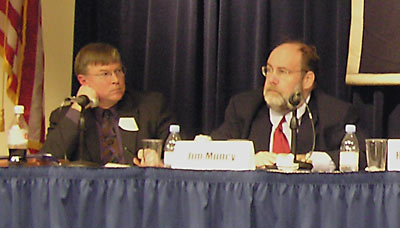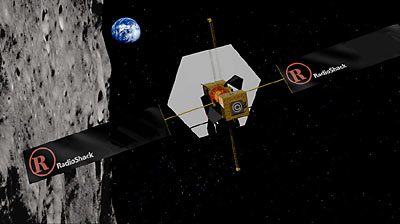Commercializing the new space initiativeby Jeff Foust
|
| The biggest reason for commercializing the new initiative can be summed up in a single word: sustainability. |
One can construct a number of reasons for giving the private sector a bigger role in the exploration effort, such as cost savings to taxpayers through greater private investment. A number of mechanisms exist for commercializing portions of the plan. Public-private partnerships would put a share of the costs of particular ventures onto the private sector, in exchange for a greater set of rewards. Data purchase agreements would allow NASA to obtain the information it needed on the Moon, Mars, or other bodies, without the risk of spending its own money on a failed spacecraft mission. Prizes, popular among space advocates for years, have now been adopted by NASA in its Centennial Challenges program, although at an initially low level: $20 million in the 2005 budget proposal.
However, the biggest reason for commercializing the new initiative can be summed up in a single word: sustainability. In the first public hearing by the President’s Commission on Moon, Mars, and Beyond, chairman Pete Aldridge immediately identified the difficulties in sustaining a program that will last for two decades or more—though several administrations and Congresses—as the biggest challenge facing the new initiative. It is difficult to imagine that the plan put forward by Bush, even in the broad goals he described, will survive in their current form for five years, let alone 15 or 25. A more commercialized initiative, though, might be better equipped to handle changes in the plan. If, in the worst case, a future administration decided to abandon the effort altogether, at least some of the infrastructure would remain in private hands for potential continued use.
Lunar missions: a test case
One immediate aspect of the plan that seems well-suited to commercialization is a series of robotic precursor missions to the Moon. When Bush announced the initiative in January, he said that NASA would resume robotic missions to the Moon no later than 2008; NASA later said they planned a lunar orbiter mission for 2008 and a lander mission the following year. Those missions, NASA Administrator Sean O’Keefe told the House Science Committee in February, would cost a total of about $500-600 million.
| There is plenty of commercial interest in—if not always money for—lunar exploration. |
Sending spacecraft to the Moon is hardly at the cutting edge of space exploration. NASA has been mounting robotic lunar missions for over four decades (although it has done very little since the end of the Apollo program.) The former Soviet Union sent its own share of missions to Moon, while Europe’s first lunar mission, SMART-1, is gradually making its way there using ion propulsion. China and India are also planning their own initial lunar missions for later this decade.
At the same time, a number of companies have been considering their own private missions to orbit and land on the Moon. LunaCorp has been working on designs for a number of lunar orbiter and lander missions for well over a decade. TransOrbital is developing a small lunar orbiter, TrailBlazer, that is scheduled for launch later this year. Several years ago SpaceDev studied flying a commercial lunar orbiter, and more recently carried out a study for a robotic observatory deployed on the surface of the Moon. In short, there is plenty of commercial interest in—if not always money for—lunar exploration.
The precursor lunar missions would appear to be a perfect way to experiment with ways to commercialize the new space initiative. NASA could, for example, sign data purchase agreements with companies operating commercial missions for specific data sets, be they high-resolution imagery of specific regions of the surface or spectroscopic data on regions of the lunar poles thought to harbor deposits of water ice. NASA could create a prize for the first mission to return a certain amount of samples from a specified region of the Moon. The agency could also simply work out an agreement to fly a NASA-supplied instrument on a planned commercial mission for a set fee. Any combination of these efforts could return the same data as missions built and operated by NASA for potentially a fraction of the cost.
While the cost savings of commercialization might seem compelling, this is not a direction NASA appears to be moving in. SPACE.com reported on February 13 that NASA has assigned the Goddard Space Flight Center as the lead center for the missions, and a team there is already starting planning for the 2008 orbiter mission. The approach implies that those missions will be done either in-house or contracted out, with limited, if any, opportunities for commercialization. “2008 is coming up awfully fast,” one NASA official said, implying that the agency had little chance to consider alternative approaches.
 Jim Dunstan (left) and Jim Muncy discuss the role of commercial lunar missions in the exploration agenda during a February 17 forum at Georgetown Law School. (credit: J. Foust) |
While there’s no indication that commercial capabilities played a role in that decision, NASA arguably could be rightly skeptical of a commercialized lunar mission. LunaCorp, for example, has yet to fly a mission after over a decade’s worth of planning, while TransOrbital has seen the launch date for TrailBlazer gradually slip to the right. Other ventures, such as Applied Space Resources, which made a big splash in the late 1990s with plans for a series of lunar sample return missions, have since disappeared.
| Muncy sees commercialization of lunar missions as a “litmus test” for the role the private sector can play in the new initiative. “It’s the $64 billion question.” |
Regardless, that decision doesn’t sit well with some commercial advocates. “Goddard hasn’t done anything with the Moon,” said Jim Dunstan, a co-founder of LunaCorp, during a panel discussion on space policy held February 17 at the Georgetown Law School in Washington DC. “Why suddenly have we decided that Goddard is the place to go for lunar knowledge? If I wanted to go to the Moon, the guys I would be calling up would be Alan Binder, who designed the Lunar Prospector mission, or the guys who built the Clementine mission. NASA really needs to look at the private sector.”
Jim Muncy of PoliSpace, speaking at the same forum, sees commercialization of lunar missions as a “litmus test” for the role the private sector can play in the new initiative. “If NASA can’t figure out how to deal with real businessmen to do as fairly pedestrian an exploration mission as a survey of the lunar poles, then it doesn’t speak very well of the role of the private sector and entrepreneurial creativity in the rest of the agenda,” he said. “It’s the $64 billion question.”
Other entrepreneurs are less skeptical about NASA’s plans. “With the entry of NASA into the equation it actually enhances the commercial prospects for TransOrbital,” said company president Dennis Laurie in an interview. “In addition to our normal commercial opportunities we now have the possibilities connected with NASA programs and their associated vendors. Those are prospective customers that did not exist in our business plan prior to the president’s notice about returning to the Moon.”
The broader role of commercialization
Beyond robotic lunar missions the role of the commercial sector in the new space initiative remains as sketchy as the details of the initiative itself. Speaking at a Marshall Institute space policy forum in Washington on February 20, Stu Nozette, a program manager at DARPA and one of the principles behind the Clementine mission a decade ago, said he sees “synergies” between NASA’s goals and the commercial sector. Those opportunities range from communications in the near term to “wealth creation through resource extraction” on the Moon 15 to 30 years down the road. “One of the things a program like this will do is really encourage people to get into the space business,” he said.
Although NASA doesn’t appear to be interested in a commercial role for the initial robotic lunar missions, officials say they’re willing to look at the possibilities for commercialization in other aspects of the initiative. “We plan to take full advantage of commercial capabilities and services where we can,” said Doug Comstock, Director of Strategic Investments at NASA Headquarters, during a February 26 space policy discussion organized by Women in Aerospace. “I think there will be opportunities based on the capabilities available.”
| “We plan to take full advantage of commercial capabilities and services where we can,” said Doug Comstock of NASA. “I think there will be opportunities based on the capabilities available.” |
While the commercial sector may not have the capabilities or resources to pull off every aspect of the proposed exploration agenda, there are roles that private industry can play beyond being a contractor. “Nobody, even Bill Gates if you gave him a huge tax subsidy, is going to take on the whole job of sending 100 people over a period of years to Mars,” said Muncy. “But Bill Gates could fund a lunar mission with pocket change. I suspect that if Bill Gates funded it with his own money, he would have more of an investment of making sure that it succeeded than the average government employee or aerospace contractor. There is something to having your own money in the game.”
In the short term, commercialization may be largely irrelevant to the ability of NASA to successfully achieve the milestones President Bush laid out in January. In the long run, however, if this initiative is to truly follow in the footsteps of Lewis and Clark, it may prove essential to involve the private sector to ensure that the development of space is not forever reliant on the capricious nature of government budgets.
